国际贸易英语Uint 1
国际贸易实务(第五版)课件第1章 TRADE TRADES(中英对照)解析
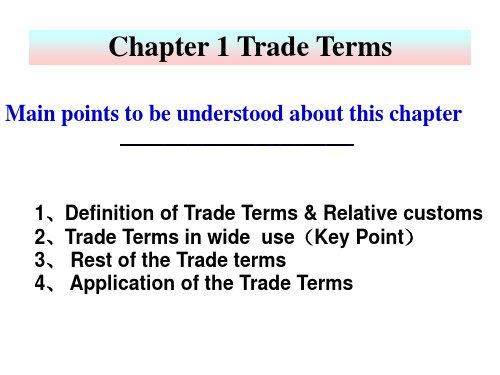
B. All customs formalities for the export of goods
C. Deliver the goods to the carrier at the named place on the date or within the agreed period
THE SECTION ONE 1、THE DEFINITION OF TRADE TERMS
Example:国内报价:每吨1000元
国际报价: PER METRIC TON USD1000 FOB GUANGZHOU
The trade terms refer to using a brief English concept or abbreviation (缩写)of English letters to indicate the formation of the unit price and determine the responsibilities, expenses and risks borne(承担) by two parties as well as the time of the passing of the property in the goods.
2、使用DDP术语应注意的问题 (1)进口清关 (2)运输方式 (3)妥善办理投保事项
The second group:
Suitable for water transport modes 《INCOTERMS 2010》
一、FAS(Free alongside ship,船边交货)
This rule is to be used only for sea or inland wate rway transport. “Free Alongside Ship” means tha t the seller delivers when the goods are placed al ongside the vessel nominated by the buyer at the named port of shipment. The risk of loss of or da mage to the goods passes when the goods are al ongside the ship, and the buyer bears all costs fr om that moment onwards.
《国际贸易实务》(英文版)_词汇
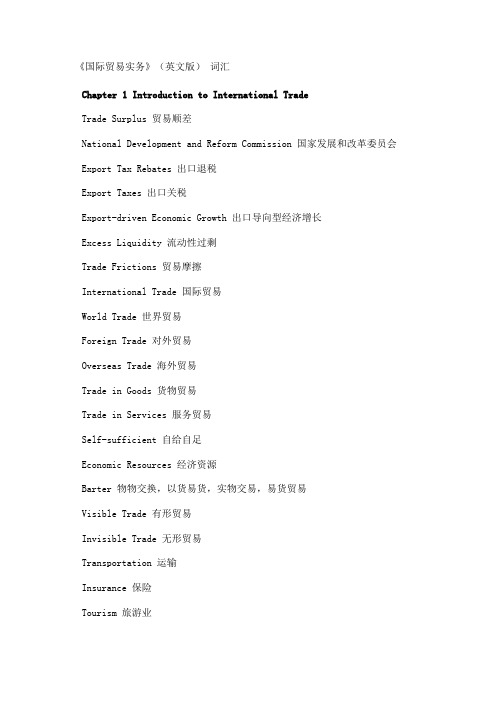
《国际贸易实务》(英文版)词汇Chapter 1 Introduction to International TradeTrade Surplus 贸易顺差National Development and Reform Commission 国家发展和改革委员会Export Tax Rebates 出口退税Export Taxes 出口关税Export-driven Economic Growth 出口导向型经济增长Excess Liquidity 流动性过剩Trade Frictions 贸易摩擦International Trade 国际贸易World Trade 世界贸易Foreign Trade 对外贸易Overseas Trade 海外贸易Trade in Goods 货物贸易Trade in Services 服务贸易Self-sufficient 自给自足Economic Resources 经济资源Barter 物物交换,以货易货,实物交易,易货贸易Visible Trade 有形贸易Invisible Trade 无形贸易Transportation 运输Insurance 保险Tourism 旅游业Balance of Trade 贸易差额A Favorable Balance of Trade 贸易顺差Trade Surplus 贸易顺差An Unfavorable Balance of Trade 贸易逆差Trade Deficit 贸易逆差Balance of Payments 国际收支平衡,国际收支差额A Favorable Balance of Payments 国际收支顺差An Unfavorable Balance of Payments 国际收支逆差International Monetary Fund(IMF)国际货币基金组织Foreign Direct Investment(FDI)对外直接投资,外商直接投资Portfolio Investment 间接投资Chapter 2 International Trade PolicyProtectionism 贸易保护主义Free Trade 自由贸易The National Interest 国家利益Doha Trade Talks 多哈贸易谈判Acquisitions 购并Trade Barriers 贸易壁垒Infant Industries 幼稚产业Tariffs 关税Subsidies 补贴Quantitative Restrictions 数量限制Encouragements 鼓励Import Tariff 进口关税Non-tariff Barriers(NTB)非关税壁垒Export Taxes 出口关税Export Subsidies 出口补贴Protective Tariffs 保护性关税Revenue Tariff 财政关税Specific Duties 从量税Ad Valorem Duties 从价税Compound Duties 复合税Harmonized Tariff Schedule of the United States(HTS)美国协调关税明细表Harmonized System 商品名称及编码协调制度International Harmonized Commodity Coding and Classification System 商品名称及编码协调制度World Customs Organization 世界海关组织Customs Tariff of Import/Export of the People’s Republic of China 中华人民共和国进出口关税条例Import Quota 进口配额Binding Quota 限制性配额Non-binding Quota不具约束力的配额Zero QuotaAbsolute Quotas 绝对配额Tariff-rate Quotas 关税配额Voluntary Export Restraint(VER)自动出口限制Multi-Fiber Arrangement 多种纤维协定Market Failures 市场失灵Domestic Content Requirements 国内成分要求Government Procurement Policies 政府采购政策Buy America Act of 1933 1933年购买美国货法案Red-tape Barriers进口环节壁垒Domestic Supply 国内供给Domestic Demand 国内需求Floor Price 最低限价Shortfall of Supply 供应短缺Export Enhancement Program(EEP)美国的出口促进计划Dairy Export Incentive Program(DEIP)奶制品出口激励项目Chapter 3 Trade Bloc and Trade BlockAsia-Pacific Economic Co-operation Organization (APEC)亚太经合组织Hanoi 河内(越南首都)Stalemate 僵局Open Regionalism 开放的区域主义Trade Liberalization 贸易自由化Most Favored Nation 最惠国Multilateralism 多边贸易Doha Round 多哈回合Free Trade Agreement of Asia and the Pacific(FTAAP)亚太自由贸易协定Free Trade Area 自由贸易区Preferential Trade Agreements(PTAs)特殊优惠贸易协议Bilateral Free Trade Agreements 双边自由贸易协定Discriminatory Tariffs 歧视性关税Tariff Rates 关税税率Trade Discrimination 贸易歧视Trade Bloc 贸易集团Trade Block 贸易禁运EU(European Union)欧盟(欧洲联盟)NAFTA(North American Free Trade Agreement)北美自由贸易协定,北美自由贸易区MERCOSUR(Mercado Comun del Cono Sur)南方共同市场SCCM(Southern Common Markets)南方共同市场ASEAN(Association of Southeast Asian Nations)东南亚国家联盟EFTA(European Free Trade Area)欧洲自由贸易区ASEAN Free Trade Area(AFTA)东盟自由贸易区Customs Union 关税同盟EEC(European Economic Community)欧洲经济共同体EC(the European Community)欧洲共同体Economic Union 经济同盟,经济联盟Trade Embargoes 贸易禁运Economic Sanctions 经济制裁United Nations 联合国Stamp Act 印花税法案Townshend Acts 汤森条例Trade Elasticity 贸易弹性Chapter 4 WTO:A Navigation GuideFranchises 特许经营World Trade Organization(WTO)世界贸易组织Uruguay Round 乌拉圭回合General Agreement on Tariffs and Trade(GATT)关税与贸易总协定Doha Development Agenda 多哈发展议程(多哈回合谈判)WTO Agreements 世界贸易组织协议The World Bank 世界银行International Monetary Fund(IMF)国际货币基金组织Appellate Body 上诉机构Dispute Settlement Panels 争端解决专门小组Plurilateral Committees 诸边协议委员会Ministerial Conference 部长会议The General Council 常务理事会The Dispute Settlement Body 争端解决机构The Trade Policy Review Body 贸易政策审议机构Goods Council 货物贸易理事会Services Council 服务贸易理事会TRIPS Council 与贸易有关的知识产权理事会The Textiles Monitoring Body 纺织品监督机构Heads of Delegations(HOD)代表团首脑The Secretariat 秘书处Sustainable Development 可持续发展Plurilateral Trade Agreement 诸边贸易协定Marrakesh Ministerial Meeting 马拉喀什部长会议(摩洛哥)TRIPS Agreement 与贸易有关的知识产权协定Trade-Related Aspects of Intellectual Property Rights(TRIPS)与贸易有关的知识产权Contracting Parties 缔约国Trade Without Discrimination 贸易无歧视Most-Favored-Nation Treatment 最惠国待遇National Treatment 国民待遇Transparency 透明度Access to Markets 市场准入Navigation Guide 导航General Agreement on Trade in Services(GATS)服务贸易总协定Trade-Related Investment Measures TRIMS 与贸易有关的投资措施Chapter 5 Terms of Commodity——QualityCommodity 商品、货物Manufactured Goods 工业制成品Name of Commodity 货物的品名Description of Goods 货物的名称,货物的描述Quality of Commodity 货物的品质Sample 样品Representative Sample 代表性样品Original Sample 原样Type Sample 标准样品Reference Sample 参考样品Duplicate Sample 复样Sale by Sell’s Sample 凭卖方样品买卖(销售)Sale by buyer’s Sample 凭买方样品买卖(销售)Return Sample 回样Counter Sample 对等样品Sealed Sample 封样The Parties to the Contract 合同的当事人Quality to be about equal to the Sample 品质与样品大致相同Specifications 规格Grade 等级Standard 标准Fair Average Quality(F.A.Q.)良好平均品质Good Merchantable Quality(G.M.Q.)上好可销品质Brand 品牌Trademark 商标Description,Drawing and Diagram 说明书,图纸和技术协议书等Quality Tolerance 品质公差Chapter 5 Terms of Commodity——QuantityQuantity of Commodity 货物的数量Unit of Measurement 计量单位The Metric System 公制The British System 英制The U.S. System 美制Numbers 个数Weight 重量Length 长度Area 面积Volume 体积Capacity 容积International Measurement Conference 国际测量会议International System of Units(SI)国际单位制Gross Weight 毛重Net Weight 净重Gross for net 以毛作净Conditioned Weight 公量Theoretical Weight 理论重量More of Less Clause 溢短装条款Chapter 5 Terms of Commodity——PackingPaking 包装Nude Cargo 裸装货Cargo in Bulk 散装货Outer Packing 外包装Baling 打包Hogsheads 美国橡木桶Inner Packing 内包装Pallet 托盘Shipping Mark 运输标志(唛头)Additional Mark 附属性标志Indicative Mark 指示性标志Warning Mark 警告性标志Neutral Packing 中性包装Neutral Packing with Designated Brand 定牌中性包装Neutral Packing without Designated Brand 无牌中性包装Chapter 6 International Trade TermsL/C Issuing Date 信用证的开证日期Partial Shipment 分批装运Transshipment 转运Shipment 装运Terms of Payment 支付条件Draft 汇票Liner 班轮Trade Terms,Price Terms,Delivery Terms 贸易术语,价格术语,交货术语Warsaw-Oxford Rules 1932 1932年华沙——牛津规则International Law Association 国际法律协会Revised American Foreign Trade Definitions 1941 1941年美国对外贸易定义修正本INCOTERMS 2000 2000年国际贸易术语解释通则International Chamber of Commerce(ICC)国际商会Carrier 承运人Frontier 边境Clear 清关Value added tax(VAT)增值税United Nations Commission on International Trade Law(UNCITRAL)联合国国际贸易法律委员会Ship’s Rail 船舷Quay 码头Multi-modal Transport 多式联运Trim 平舱Stow 理舱EXW 工厂交货FCA 货交承运人FOB 装运港船上交货FAS 货交船边CFR 成本加运费CIF 成本加保险费加运费CPT 运费付至CIP 运费、保险费付至DAF 边境交货DES 目的港船上交货DEQ 目的港码头交货DDU 未完税交货DDP 完税后交货。
Unit1概述
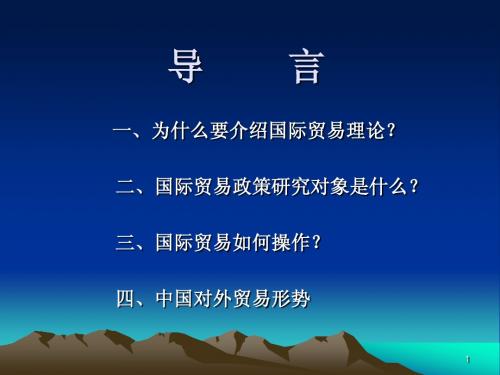
28
国际分工与国内分工(续) 国际分工与国内分工(
◆区别
DDL *形成时期不同 : 原始社会初 *商品交换方式不同:国内贸易 *影响因素不同: 本国生产力 影响因素不同: 本国生产力…
19
以清偿工具不同分
•自由结汇贸易(Free-liquidation Trade) Free以国际通用货币作为清偿工具的 国际贸易。 国际贸易。 •易货贸易(Barter Trade) 以经过计 价的商品作为清偿工具的国际贸易。 的商品作为清偿工具的国际贸易 作为清偿工具的国际贸易。
20
依有无第三国中介分
专门贸易 = 专门进口 + 专门出口
*德、法、意、瑞士等80多国与地区采用 瑞士等 多国与地区采用
17
以商品形态分
•
货物贸易(Commodity Trade) 物质性商品的进出口, 物质性商品的进出口,也称有形贸易
(Visible Trade) 提供者 从一国境内、 从一国境内、通过商业现场或自然人的商 业现场向消费者提供服务,并获取外汇收 业现场向消费者提供服务, 入的过程。 入的过程。也称无形贸易(Intangible Trade)
14
依商品流向分
•出口贸易(Export Trade) A 出口贸易( •进口贸易(Import Trade) 进口贸易( A T B B B
•过境贸易(Transit Trade) A 过境贸易(
15
按统计标准分
•以国境为标准:总贸易(General Trade) 总贸易( 凡进入本国国境的商品一律列为进口,称总进 凡进入本国国境的商品一律列为进口, 凡离开本国国境的商品都列为出口,称总出口。 口;凡离开本国国境的商品都列为出口,称总出口。
《国际贸易》unit 1
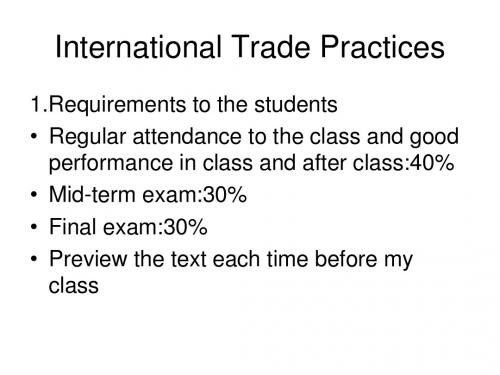
• Invisible Trade Revenue and expenditure incurred by exchange of services and other nonmaterial commodities. • Income and expenses concerning the import and export of commodities, e.g. freight, premium, processing charges. • Income and expenses irrelevant to the import and export of commodities, e.g. traveling expenses, diplomatic agent expenses, overseas remittances, franchise fees, dividends paid to foreign investors, etc. • As invisibles do not go through customs clearance, they are not indicated in customs statistics, but on a country’s statement of balance of payments.
What is international trade?
International trade is the fair and deliberate
exchange of goods and services across national boundaries. International trade vs. foreign trade
Teaching objectives:
Unit One International Trade
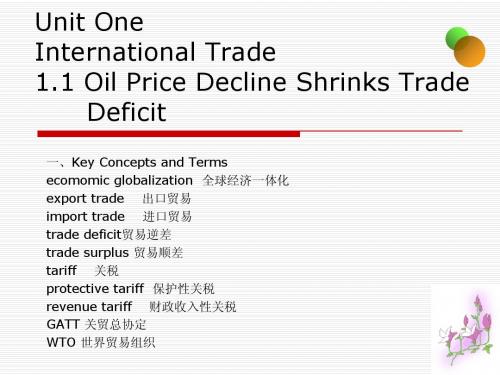
1.3 Dire Forecast for the Global Economy and World Trade
经济报刊常用词和术语
1 capital flow 资金流动 2 the projections are among the most dire in a litany of recent gloomy prognostications for the world economy ,在对世界经济冗 长的悲观预测中,最可怕的是对未来形势的估计。 in a litany : a long boring account of a series of events,reasons. 3 prognostication: telling sth. in advance 4 economy will eke out growth of 0.9 percent.世界经济增长勉强维持 在0.9%。 eke out :manage to make 5 the International Monetary Fund 国际货币基金组织
Unit One International Trade 1.1 Oil Price Decline Shrinks Trade Deficit
一、Key Concepts and Terms ecomomic globalization 全球经济一体化 export trade 出口贸易 import trade 进口贸易 trade deficit贸易逆差 trade surplus 贸易顺差 tariff 关税 protective tariff 保护性关税 revenue tariff 财政收入性关税 GATT 关贸总协定 WTO 世界贸易组织
capital goods资本货物 Doha round 多哈回合 political will 政治意愿 key WTO ambassadors 世贸组织的主要代表们 an uncertain period of trade 不定期贸易 trade imbalance 贸易失衡,贸易差额 producer price index 生产者价格指数 credit default index 信贷违约交换 in volume terms 按出口数量计算 in value terms 按出口值计算
国际贸易常用英语
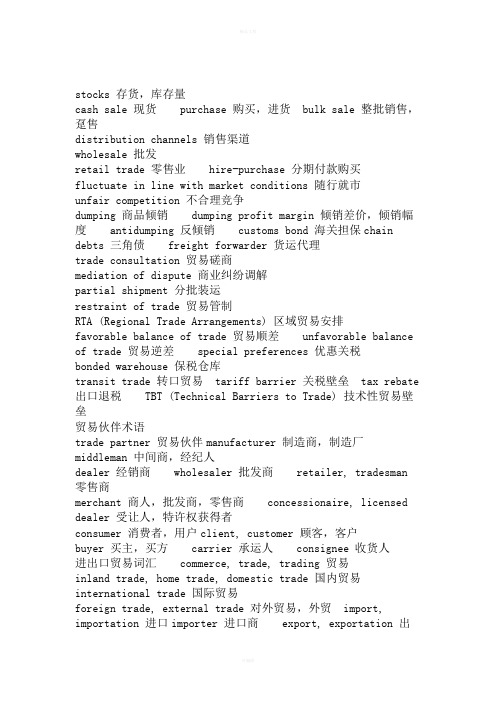
stocks 存货,库存量cash sale 现货purchase 购买,进货bulk sale 整批销售,趸售distribution channels 销售渠道wholesale 批发retail trade 零售业hire-purchase 分期付款购买fluctuate in line with market conditions 随行就市unfair competition 不合理竞争dumping 商品倾销dumping profit margin 倾销差价,倾销幅度antidumping 反倾销customs bond 海关担保chain debts 三角债freight forwarder 货运代理trade consultation 贸易磋商mediation of dispute 商业纠纷调解partial shipment 分批装运restraint of trade 贸易管制RTA (Regional Trade Arrangements) 区域贸易安排favorable balance of trade 贸易顺差unfavorable balance of trade 贸易逆差special preferences 优惠关税bonded warehouse 保税仓库transit trade 转口贸易tariff barrier 关税壁垒tax rebate 出口退税TBT (Technical Barriers to Trade) 技术性贸易壁垒贸易伙伴术语trade partner 贸易伙伴manufacturer 制造商,制造厂middleman 中间商,经纪人dealer 经销商wholesaler 批发商retailer, tradesman 零售商merchant 商人,批发商,零售商concessionaire, licensed dealer 受让人,特许权获得者consumer 消费者,用户client, customer 顾客,客户buyer 买主,买方carrier 承运人consignee 收货人进出口贸易词汇commerce, trade, trading 贸易inland trade, home trade, domestic trade 国内贸易international trade 国际贸易foreign trade, external trade 对外贸易,外贸import, importation 进口importer 进口商export, exportation 出口exporter 出口商import licence 进口许口证export licence 出口许口证commercial transaction 买卖,交易inquiry 询盘delivery 交货order 订货make a complete entry 正式/完整申报bad account 坏帐Bill of Lading 提单marine bills of lading 海运提单shipping order 托运单blank endorsed 空白背书endorsed 背书cargo receipt 承运货物收据condemned goods 有问题的货物catalogue 商品目录customs liquidation 清关customs clearance 结关国际贸易英语词汇集锦一贸易价格术语trade term / price term 价格术语world / international market price 国际市场价格FOB (free on board) 离岸价C&F (cost and freight) 成本加运费价CIF (cost, insurance and freight) 到岸价freight 运费wharfage 码头费landing charges 卸货费customs duty 关税port dues 港口税import surcharge 进口附加税import variable duties 进口差价税commission 佣金return commission 回佣,回扣price including commission 含佣价net price 净价wholesale price 批发价discount / allowance 折扣retail price 零售价spot price 现货价格current price 现行价格 / 时价indicative price 参考价格customs valuation 海关估价price list 价目表total value 总值贸易保险术语All Risks 一切险F.P.A. (Free from Particular Average) 平安险W.A. / W.P.A (With Average or With Particular Average) 水渍险War Risk 战争险F.W.R.D. (Fresh Water Rain Damage) 淡水雨淋险Risk of Intermixture and Contamination 混杂、玷污险Risk of Leakage 渗漏险Risk of Odor 串味险Risk of Rust 锈蚀险Shortage Risk 短缺险T.P.N.D. ( Theft, Pilferage&Non-delivery) 偷窃提货不着险Strikes Risk 罢工险贸易机构词汇WTO (World Trade Organization) 世界贸易组织IMF (International Monetary Fund) 国际货币基金组织CTG (Council for Trade in Goods) 货币贸易理事会EFTA (European Free Trade Association) 欧洲自由贸易联盟AFTA (ASEAN Free Trade Area) 东盟自由贸易区JCCT (China-US Joint Commission on Commerce and Trade) 中美商贸联委会NAFTA (North American Free Trade Area) 北美自由贸易区UNCTAD (United Nations Conference on Trade and Development) 联合国贸易与发展会议GATT (General Agreement on Tariffs and Trade) 关贸总协定对外贸易常用英语(1) They mainly trade with Japanese firms.他们主要和日本商行进行贸易。
国际贸易双语教程(英文版)
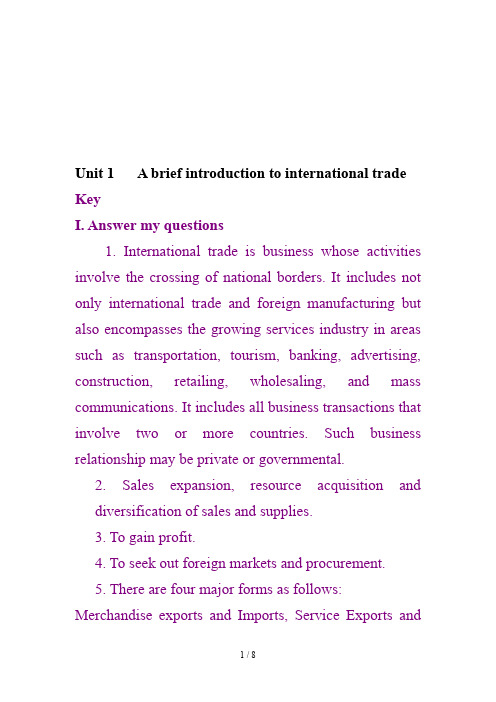
Unit 1 A brief introduction to international trade KeyI. Answer my questions1. International trade is business whose activities involve the crossing of national borders. It includes not only international trade and foreign manufacturing but also encompasses the growing services industry in areas such as transportation, tourism, banking, advertising, construction, retailing, wholesaling, and mass communications. It includes all business transactions that involve two or more countries. Such business relationship may be private or governmental.2. Sales expansion, resource acquisition anddiversification of sales and supplies.3. To gain profit.4. To seek out foreign markets and procurement.5. There are four major forms as follows: Merchandise exports and Imports, Service Exports andImports, Investment, and Multinational Enterprise.6. It is the account which is a summary statement of the flow of all international economic and financial transactions between one nation (eg.the United States ) and the rest of the world over some period of time, usually one year.7. Merchandise Exporting and Importing.8. Yes. There are great differences between them.1) direct investment takes place when control follows the investment. It usually means high commitment of capital, personnel, and technology abroad. It aims at gaining of foreign resources and foreign markets. Direct investment may often get higher foreign sales than exporting. And sometimes it involves two or more parties.2) While portfolio investments are not under control. And they are used primarily for financial purposes. Treasures of companies, for example, routinely more funds from one country to another to get a higher yield on short term investments.9. MNE is the abbreviation of the multinational enterprise. Its synonyms are NNC (the multinational corporation) and TNC (transnational corporation).10. Examples are travel, transport, fee, royalties, dividends and interest.11. The choice of forms is influenced by the objective being pursued and the environments in which the company must operate.12. It is limited by the number of people interested ina firm’s products and services and by customers’ capacity to make purchase.13. This is because at an early stage of international involvement these operations usually take the least commitment and least risk of a firm’s resources.14. Royalties means the payment for use of assets from abroad, such as for trademarks patens, copyrights, or other expertise under contract known as licencing agreements.Royalties are also paid franchising.15. It is a way of doing business in which one party (the franchiser) the use of a trademark that is an essential asset for the franchisers’ business.II Match each one on the left with its correct meaning on the right1. J2.A3.E4.B5.C6.D7.I8.G9.F 10.HIII Translate the following terms and phrases into Chinese1 购买力11经济复苏;恢复2潜在销售量12 经济衰退3加价,涨价13间接投资4国内市场14有形货物5制成品15有形进出口6边际利润16收入及支出;岁入及岁出7市场占有率17超额能力8贸易歧视18贸易中间人(商);经纪人9时机选择19全部包建的工程承包方式10经销周期20许可证协定IV Case Study1 [Answer]:Batteries called "white elephant" exported from China were very popular in Southeast Asia, because "white elephant" was a lucky thing in Southeast Asia, but no one was interested in it in the market of Europe and the United States. The boss of the company was very strange that the quality of the battery or the price of。
国际贸易第一章(英文)
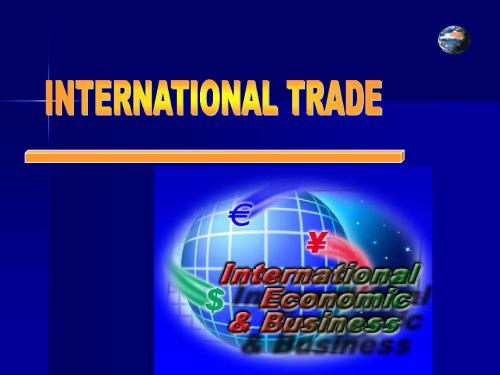
1.3.4 Direct Trade / Indirect Trade / Entrepot Trade
Direct Trade:the goods are diretly transported from the producer to the consumer. Indirect Trade:Goods are sold through the third country or other intermediary distribution to the consumer EXP: A—B B– C Entrepot trade:A State or regions import commodities not for consuming but for further exporting to other countries.
International Trade
Arrangement:
1.Introduction to International Trade:The
definition of international trade ;the classification and some important concept 2. The theory:mainly introduce the traditional western theory and it’s Opposition ; New International Trade Theory 3.The policy:analyzing the Tariff measures , Non-tariff measures and the Economic impact on a country ;introducing the WTO and International trade treaties
第一章 Introduction to International Trade 《国际贸易实务》PPT课件
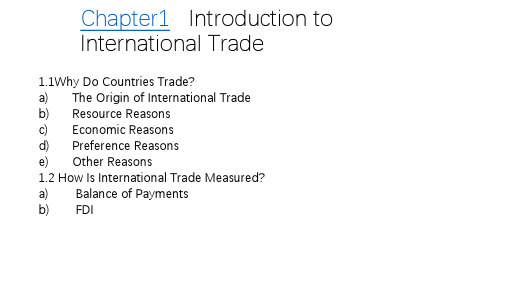
• Other nations depend on trade for a large part of their national income and to supply goods for domestic consumption.
FDI
Foreign Direct Investment (FDI) is the buying of permanent property and business in foreign nations. It can take the form of either direct or portfolio investment. Direct investment occurs when acquisition of equity interest in a foreign company is made. This interest may vary between a small percentage and a controlling interest of a company’s equity. (Ownership of more than 50% is not necessary in securing a controlling interest in a company). Controlling interest in a foreign company represents a high level of commitment to foreign operations and is usually accompanied by personnel and technology transfers abroad. The appeal of direct investment lies with the access to market and resources as well as rationalization of global production afforded by such an arrangement.
国际贸易实务(第五版)课件第1章-TRADE-TRADES(中英对照)详解
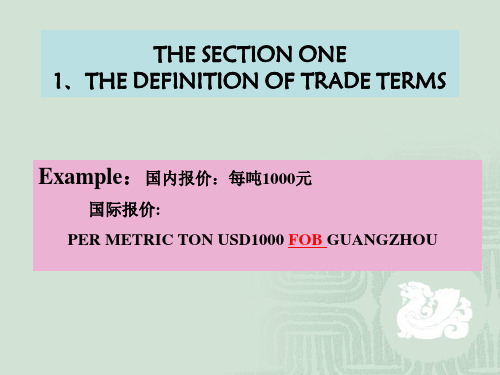
Ti of Origin
FOB, FAS, C&F, CIF, Ex Dock
Warsaw-Oxford Rules 1932
International Law Association
1928 CIF
Incoterms 2010
International Chamber of Commerce
A. Provision(提供) of the goods in conformity with the contract
B. All customs formalities for the export of goods
C. Deliver the goods to the carrier at the named place on the date or within the agreed period
DEQ (Delivered ex quay)
《1932年华沙一牛 国际法协会
1928-1932
CIF
津规则》
《1990年美国对外 美国商业团体
1919-1990
6种
贸易定义修订本》
《2010年国际贸易 术语解释通则》
国际商会
1936-2010
11种
注:目前最新的通则为:《2010年国际贸易术语解释通则》,包括11 种贸易术语
3.Structure of INCOTERMS 2010
The first group:Suitable for all kinds of transport modes 适合于各种运输方式的术语 EXW,FCA,CPT,CIP,DAT,DAP,DDP
The second:Suitable for water transportation 适合于水上运输的贸易术语 FAS,FOB,CFR,CIF
Internationaltrade英语专业专业必修课国际贸易实务英文版课堂笔记整理
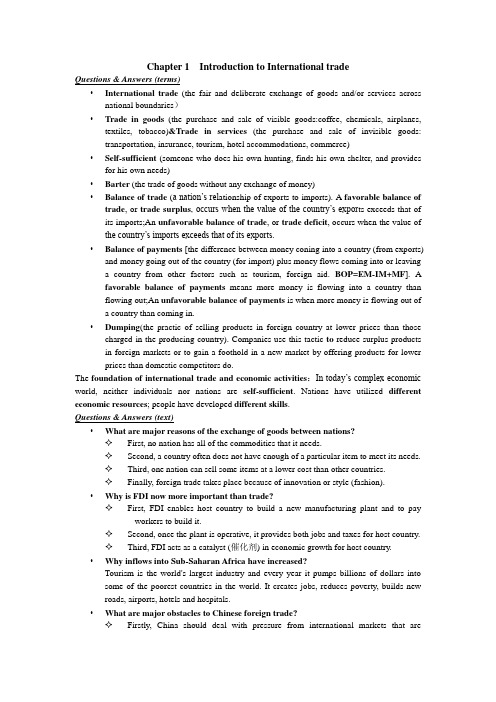
Chapter 1 Introduction to International tradeQuestions & Answers (terms)•International trade(the fair and deliberate exchange of goods and/or services across national boundaries)•Trade in goods (the purchase and sale of visible goods:coffee, chemicals, airplanes, textiles, tobacco)&Trade in services(the purchase and sale of invisible goods: transportation, insurance, tourism, hotel accommodations, commerce)•Self-sufficient (someone who does his own hunting, finds his own shelter, and provides for his own needs)•Barter (the trade of goods without any exchange of money)•Balance of trade (a nation’s rel ationship of exports to imports). A favorable balance of trade, or trade surplus, occurs when the value of the country’s expor ts exceeds that of its imports;An unfavorable balance of trade, or trade deficit, occurs when the value of the country’s imports exceeds that of its exports.•Balance of payments [the difference between money coning into a country (from exports) and money going out of the country (for import) plus money flows coming into or leavinga country from other factors such as tourism, foreign aid.BOP=EM-IM+MF]. Afavorable balance of payments means more money is flowing into a country than flowing out;An unfavorable balance of payments is when more money is flowing out ofa country than coming in.•Dumping(the practic of selling products in foreign country at lower prices than those charged in the producing country). Companies use this tactic to reduce surplus products in foreign markets or to gain a foothold in a new market by offering products for lower prices than domestic competitors do.The foundation of international trade and economic activities:In today’s complex economic world, neither individuals nor nations are self-sufficient. Nations have utilized different economic resources; people have developed different skills.Questions & Answers (text)•What are major reasons of the exchange of goods between nations?✧First, no nation has all of the commodities that it needs.✧Second, a country often does not have enough of a particular item to meet its needs.✧Third, one nation can sell some items at a lower cost than other countries.✧Finally, foreign trade takes place because of innovation or style (fashion).•Why is FDI now more important than trade?✧First, FDI enables host country to build a new manufacturing plant and to payworkers to build it.✧Second, once the plant is operative, it provides both jobs and taxes for host country.✧Third, FDI acts as a catalyst (催化剂) in economic growth for host country.•Why inflows into Sub-Saharan Africa have increased?Tourism is the world's largest industry and every year it pumps billions of dollars into some of the poorest countries in the world. It creates jobs, reduces poverty, builds new roads, airports, hotels and hospitals.•What are major obstacles to Chinese foreign trade?✧Firstly, China should deal with pressure from international markets that aregradually becoming saturated(饱和).✧Secondly, the cost of Chinese exports is increasing, partly because of the highercost of labor and environmental protection.✧Thirdly, increasing international trade protection has caused China to stumble into(陷入)difficult territory.✧Finally, the trade imbalance between China and other countries is getting worse.Chapter 2 Basic Theory of International TradeQuestions & Answers (terms)•Opportunity Cost机会成本:有一得必有一失(the amount of another goods or service that might otherwise have been produced)•Absolute Advantage两者相权取成本低、效率高者[A commodity will be produced in the country where it costs least in terms of resources (capital, land, and labor).] Comparative Advantage两利相权取其重,两劣相权取其轻only one of the goods would work "most best" and "least worse"•What the Theory of C-A Shows if we want to maximize total output in the world then:✧first, fully employ all resources worldwide;✧second, allocate those resources within countries to each country's comparativeadvantage industries;✧third, allow the countries to trade freely .•Specialization (there were some things he was more capable of doing and it would benefit him to concentrate his efforts on the production of those goods in which he was particularly proficient)What are the major benefits of exporting?Why export? Y our general objectives will probably be:➢To increase profitability➢To utilise production capacity to the full➢The small domestic market may not big enough for growth➢You may be manufacturing a specialised product and find there are not enough customers in Sweden➢You may be looking for the increased security your company can achieve by spreading its risks over a variety of markets➢You may want to ensure that your product is kept up to date by exposure to competition in international markets➢It provides scope to develop a company's strengths and abilities. Selling in aninternational environment will sharpen your innovative edge and open up opportunities that might never come your way if you limit yourself to the home market.Michael Porter’s Diamond ModelMichael Porter of the Harvard Business School introduced a new competitiveness theory, the so-called diamond model. He argues that national prosperity is not inherited, but created by choices; in other words, national wealth is not set by factor endowments, but created by strategic choices. He intro duced a concept of “clusters”, or groups of interconnected firms, suppliers,related industries, and institutions that arise in particular locations.1. Firm strategy, Structure and RivalryThe world is dominated by dynamic conditions, and it is direct competition that impels firmsto work for increases in productivity and innovation.2. Demand ConditionsThe more demanding the customers in an economy, the greater the pressure facing firms to constantly to improve their competitiveness via innovative products, through high quality, etc.3. Related Supporting IndustriesUpstream or downstream industries facilitates the exchange of information and promotes a continuous exchange of ideas and innovations.4. Factor ConditionsContrary to conventional wisdoms, Po rter argues that the “key” factors of production (or specialized factors) are created, not inherited. Specialized factors are skilled labor, capital and infrastructure. “Non-key” factors or general use factors, such as unskilled labor and raw materials, can be obtained by any company and, hence, do not generate sustained competitive advantage. However, specialized factors involve heavy, sustained investment. They are more difficult to duplicate. This leads to a competitive advantage, because if other firms cannot easily duplicate these factors, they are valuable.The role of government in Porter’ Diamond Model is “acting as a catalyst and challenger; it is to encourage—or even push—companies to raise their aspirations and move to higher levels of competitive performance…”.They must encourage companies to raise their performance, stimulate early demand for advanced products, focus on specialized factors creation and to stimulate local rivalry by limiting direct cooperation and enforce anti-trust(反托拉斯,反垄断)regulations.Chapter 5 International Trade TermsRole of International Trade Terms➢Standing for specific obligations of the buyer and the seller.➢Name the exact point at which the ownership of the merchandise is transferred from the seller to the buyer.➢Define the responsibilities and expenses of both the seller and the buyer.➢Define the nature of the contract, such as FOB contract or CIF contract, to determine expenses and risks as well as their rights and obligations accordingly.➢The use of the trade terms greatly simplifies the contract negotiations, and thus saves time and cost.The price of commodity(refers to the unit price, which is made up of a name of currency, a unit price, a measuring unit, a trade term, and a name of destination or shipping place .For example,US$ 800 per M/T CIF London)国际贸易合同的主要条款有: 合同对象(标的):commodities or services 合同总值: total value or quantities 交货条件: trade terms 包装: packaging 装运期: shipment装运口岸和目的地: departure port or destination 保险: insurance 支付条款: payment Procedures of Marine Insurance•To apply for marine insurance;•To determine the insurance value of the goods to be insured;•To determine the insurance average and coverage;•To determine insurance premium;•To sign an insurance policy•To lodge an insurance claim.Proper pricing, complete and accurate quotations, and choice of terms of sale and payment are four critical elements in selling a product or service internationally. Of the four, pricing is the most problematic, even for the experienced exporter.Export product cost structure, involving cost of production, selling and delivery costs, and customs duties.Pricing Considerations•At what price should the firm sell its product in the foreign market?•What type of market positioning does the company want to convey from its pricing structure?•Does the export price reflect the product's quality?•Is the price competitive?•Should the firm pursue market penetration or market-skimming pricing objectives abroad?•What type of discount (trade, cash, quantity) and allowances (advertising, trade-off) should the firm offer its foreign customers?•Laws pose a problem?•Should prices differ by market segment?•What should the firm do about product line pricing?•What pricing options are available if the firm's costs increase or decrease?•Is the demand in the foreign market elastic or inelastic?•Are the prices going to be viewed by the foreign government as reasonable or unfair?•Do the foreign country's antidumping?Pricing Summary Here are the key points to remember when determining your product's price: •Determine the objective in the foreign market.•Compute the actual cost of the export product.•Compute the final consumer price.•Evaluate market demand and competition.•Consider modifying the product to reduce the export price.•Include “non-market" costs, such as tariffs and customs fees.•Exclude cost elements that provide no benefit to the export function, such as domestic advertising.In the cost-plus method of calculation, the exporter starts with the domestic manufacturing cost and adds administration, research and development, overhead, freight forwarding, distributor margins, customs charges, and profit. The effect of this pricing approach may be that the export price escalates into an uncompetitive range.The actual payment= the full invoice of the goods +the additional charges of expenses the seller has paid.Stages in Handling a Bill of Exchange•To draw•Presentation and acceptance•Endorsement•Without recourse•Payment•Dishonor and recourse。
国际贸易专业英语单词
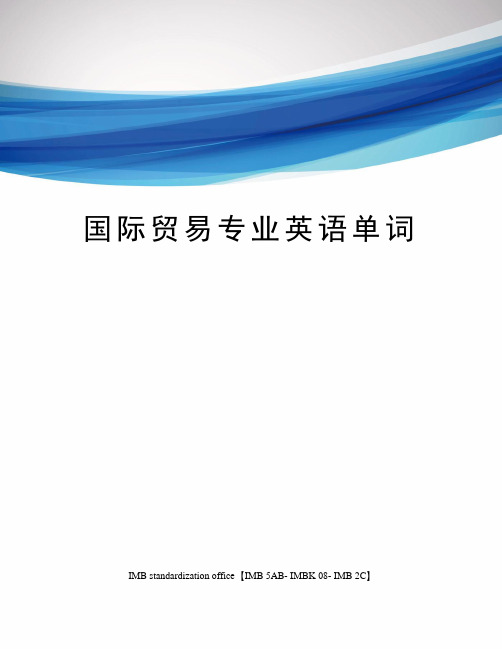
国际贸易专业英语单词 IMB standardization office【IMB 5AB- IMBK 08- IMB 2C】国际贸易专业英语Unit 1mercantilism重商主义;export出口;import进口;precious metal贵金属;restrain import限制进口;encourage export鼓励出口;early(late) mercantilism早期(晚期)重商主义;bullionism重金主义;favorable balance of trade; positive trade balance;trade surplus贸易顺差;trade deficit; unfavorable balance of trade;negative trade balance贸易逆差;balance of bargains贸易差额论barter; barter trade易货贸易;hard currency硬通货;physiocrat重农主义者;physiocracy重农主义;laissez-faire自由主义;monopoly垄断;tariff关税;quota配额;prohibition禁令;skilled labor熟练劳动力;manufactured goods制成品port duty入港税;country of origin原产地;The wealth of Nations国富论;positive-sum game正和游戏;zero-sum game零和游戏;specialization专业化;economies of scale规模经济;welfare福利; 1 free-market economics自由市场经济classical economist古典经济学家;oversupply供大于求;过度供给;inflation通货膨胀;Industrial Revolution工业革命;free trade policy自由贸易政策;protectionism保护贸易主义;international monetary system国际货币体系;gold standard金本位;exchange rate汇率;international price国际价格;devaluation贬值;depreciation贬值;appreciation升值;revaluation升值;the Great Depression大萧条;Keynesian凯恩斯主义者;countercyclical policy反周期政策;centrally planned system中央计划体制;economic affair经济事务;bilateral trading agreement双边贸易协定;foreign exchange外汇;foreign exchange control外汇管制;The Marshall Plan马歇尔计划;The Bretton Woods agreement布雷顿森林协定;GATT关税与贸易总协定;multilateral free trade多边自由贸易;economic well-being经济福利;recession衰退;neo-mercantilism新重商主义;government intervention政府干预2 Unit 2 comparative advantage比较优势;absolute advantage绝对优势;trade barriers贸易壁垒;terms of trade贸易条件;opportunity cost机会成本;perfectly competitive market完全竞争市场;Unit 3Heckscher-Ohlin-Samuelson model赫克歇尔-俄林-萨缪尔森模型;Heckscher-Ohlin-Vanek model赫克歇尔-俄林-凡奈克模型;Heckscher-Ohlin(H-O)theory赫克歇尔-俄林理论;factor proportions theory 要素禀赋理论;factor of production生产要素;capital-intensive product资本密集型产品;labor-intensive product劳动密集型产品;capital-abundant country资本充裕的国家;labor-abundant country劳动充裕的国家;the Stolper-Samuelson theorem斯托尔珀-萨缪尔森定理;the factor-price equalization theorem要素价格均等化定理/赫克歇尔-俄林-萨缪尔森定理;the Rybczynski theorem罗伯津斯基定理;rental rate租金率;wage rate工资率; 3 Leontief paradox里昂惕夫之谜;non-traded good非贸易品Unit 4new trade theory新贸易理论;conventional trade theory传统贸易理论;Harberger’s triangle哈伯格三角;deadweight loss净损失;government intervention政府干预;price floor and cap价格下限和上限;supply curve供给曲线;demand curve需求曲线;consumer surplus消费者剩余;producer surplus生产者剩余;long term长期;long run长期;income-distribution收入分配;income-distribution effect收入分配效应;technological innovation技术创新;increasing returns to scale规模收益递增;returns to scale规模收益;productivity stagnation生产力停滞;intra-industry trade产业内贸易;Unit 5economic loss经济损失;anti-dumping tariff/anti-dumping duty反倾销税;normal value正常价值;constructed value结构价值; 4 anti-dumping suit反倾销诉讼;intellectual property right知识产权;subsidy补贴;Dispute Settlement Body争端解决机构;trade dispute贸易纠纷;Department of Commerce商务部;anti-dumping tax rate反倾销税率;Custom海关Unit 6European Union欧盟;OECD (Organization for Economic Co-operationand Development )经济合作与发展组织;OEEC欧洲经济合作组织;developed (developing) countries发达(发展中)国家;sustainable economic growth持续的经济增长;emerging market economies新兴市场经济体;international trade policy国际贸易政策;the Doha round多哈回合;industrialized countries工业化国家;producer support estimate生产者支持估计量;beneficiary受益人;common agricultural policy共同农业政策;market mechanism市场机制;household income家庭收入world bank世界银行;the Agreement on Subsidies and CountervailingMeasures补贴与反补贴措施协议; 5 the Uruguay Round乌拉圭回合;the General Agreement on Tariffs and Trade 关贸总协定;the Tokyo Round东京回合prohibited subsidies禁止性补贴;actionable subsidies可申诉补贴;non-actionable subsidies不可申诉补贴;transitional arrangement过渡性安排;centrally planned economy中央计划经济;market economy市场经济;government purchase政府购买;prohibited subsidies禁止性补贴;red-light subsidies红灯补贴;actionable subsidies可申诉补贴;yellow-light subsidies黄灯补贴;non-actionable subsidies不可申诉补贴;green-light subsidies绿灯补贴Unit 7anti-dumping litigation反倾销诉讼;market access市场准入;discriminatory treatment歧视性待遇;Agreement on Safeguards特殊保障协议;Most-favored-nation treatment最惠国待遇;China’s protocol of accession to the WTO中国入世协定书;non-market economy非市场经济; 6 market economy市场经济;economic efficiency经济效益;the WTO dispute settlement procedureWTO争端解决程序dispute settlement system争端解决机制;Department of Commerce商务部;third market第三国市场;supply and demand供给与需求;labor cost劳动力成本;average cost平均成本;marginal cost边际成本;constructed value结构价值escape clause免责条款;rent-seeking behavior寻租行为Unit 8trade deficit贸易赤字;贸易逆差;入超;exchange-rate manipulator汇率操作者;bilateral trade surplus双边贸易顺差;balance of trade 贸易差额;trade gap贸易差额;domestic consumption国内消费;investment投资;global financial crisis全球金融危机;economic recession经济衰退fixed assets investment固定资产投资;trade dependency外贸依存度; 7 net value added净增加值;household consumption家庭消费;domestic demand国内需求;high-tech product高科技产品;fiscal deficit财政赤字;current account经常账户;capital and financial account资本与金融帐户;saving rate储蓄率;Unit 9Free Trade Area of the Americas/FTAA美洲自由贸易区;preferential trade arrangement优惠贸易安排;free trade area自由贸易区;custom union关税同盟;common market共同市场;economic union经济联盟;Asia-Pacific Economic Cooperation Forum/APEC亚太经济与合作组织;pan-American trade泛美贸易;regional trade agreement区域贸易协定;economic integration经济一体化;regional economic integration区域经济一体化;the Pacific Rim环太平洋地区;regional dialogue区域对话;consensual agreement自愿协议;world trading order世界贸易秩序 8 Unit 10public health公共卫生;minimum wage最低工资;trademark商标;global economy全球经济;environmental standard环境标准;labor standard劳工标准;manufacturing job生产工作;average income平均收入;real wage实际工资;nominal wage名义工资9。
国际商贸英语Unit 1 Business Negotiation in International Trade
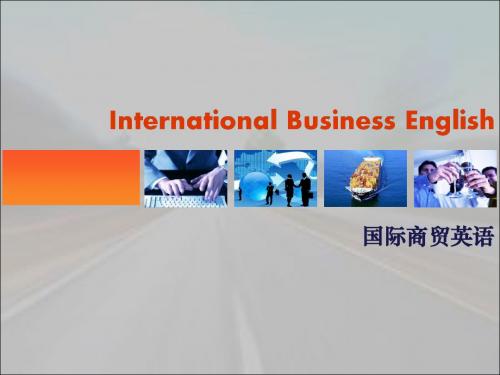
International Business English
1.2 Key elements in inquiry
International pricing You can extend the invitation by telephone. For very formal dinners or banquets, you would extend the invitation by written letters.
International Business English
Notes: Trade terms Trade terms are key elements of unit price of a certain commodity in international trade. They explain the division of costs between the seller and buyer such as freight, insurance premium and so on. The main trade terms often used in international trade are: 1)FOB+ port of shipment The buyer contracts shipment and insurance. Example: FOB Shanghai trade terms: 贸易Negotiation in International Trade
International Business English
Business negotiation is the process by which the seller and the buyer fix the terms and conditions of a business deal with the intention of reaching an agreement. The contents of a business negotiation mainly include: name of commodity, quality, quantity, packing, price, shipment, insurance and terms of payment.
国际贸易英文讲义
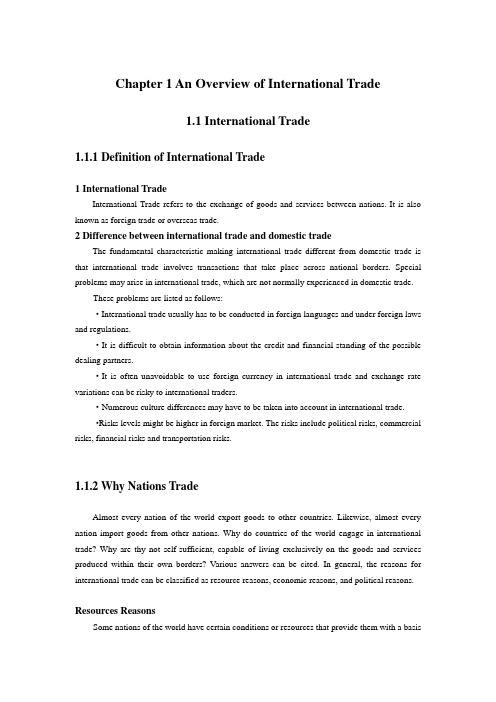
Chapter 1 An Overview of International Trade1.1 International Trade1.1.1 Definition of International Trade1 International TradeInternational Trade refers to the exchange of goods and services between nations. It is also known as foreign trade or overseas trade.2 Difference between international trade and domestic tradeThe fundamental characteristic making international trade different from domestic trade is that international trade involves transactions that take place across national borders. Special problems may arise in international trade, which are not normally experienced in domestic trade.These problems are listed as follows:·International trade usually has to be conducted in foreign languages and under foreign laws and regulations.·It is difficult to obtain information about the credit and financial standing of the possible dealing partners.·It is often unavoidable to use foreign currency in international trade and exchange rate variations can be risky to international traders.·Numerous culture differences may have to be taken into account in international trade.·Risks levels might be higher in foreign market. The risks include political risks, commercial risks, financial risks and transportation risks.1.1.2 Why Nations TradeAlmost every nation of the world export goods to other countries. Likewise, almost every nation import goods from other nations. Why do countries of the world engage in international trade? Why are thy not self-sufficient, capable of living exclusively on the goods and services produced within their own borders? Various answers can be cited. In general, the reasons for international trade can be classified as resource reasons, economic reasons, and political reasons.Resources ReasonsSome nations of the world have certain conditions or resources that provide them with a basisfor international trade. Illustrations include the following:·Favorable climate conditions and terrain. For example, Colombia and Brazil have just the right climate for growing coffee beans.·Natural resources. If a country has an abundance of natural resources, it is common to find some of these resources being exported. Tin from Bolivia and oil from the Middle East countries are examples. On the other hand, among highly industrialized nations, the raw materials are often sold in finished form. For example, the United States sells its own iron ore in the form of steal products.·Skilled workers. If a nation has a great many skilled workers, it can produce sophisticated equipment and machinery such as computers, jet aircraft, electric generators, etc.·Capital resources, Another important factor in international trade is that of capital resources. These include things such as plant, machinery, and equipment. Poor countries, of course, lack these capital resources and must rely heavily on manual labor in making goods for both domestic consumption and international trade.·Favorable geographic location and transportation costs. Nations located near each other tend to do more trading than those located thousands of miles apart.Economic ReasonsAnother reason why nations engage in international trade is to secure some kind of economic benefit. However, this gain will be obtained only if they produce and sell the right goods. In determining which goods these are, the business people of the country must understand two important principles: 1) absolute advantage, and 2) comparative advantage, which will be discussed in chapter 2 trade theories.Political ReasonsSome nations of the world trade with others for basically political reasons. For example, the former Soviet Union had trade with Cuba for two decades. Why? Because the Soviet wanted to support a government in the country that was in basic agreement with their political doctrine. The United States has traded with South Korea for a long time for similar reasons. In both cases, political objectives have outweighed economic consideration. The reverse is also true: nations often refuse to trade with others because of political disagreements.1.1.3 History of International TradeTrade between the peoples and countries of the world is as old as human history.Land and sea routes connected the first civilizations in Mesopotamia and around the Mediterranean:and thePhoenicians of the eastern Mediterranean traded metals,cedar wood,cloth,and animals across the sea as early as 3,000 BC.One of the most important land routes was the Silk Road, connecting China in the east with the Roman Empire in the west.Silks,gemstones,perfumes,and other luxury goods were carried along this route from 300 BC onwards,providing a direct link between two of the major civilizations of the world.The European end of this route was controlled first by Constantinople (Istanbul) and then by the cities of northern Italy,particularly Venice,which grew rich on the proceeds of this trade.In the 15th and 16th centuries,the development of sea-going vessels and advances in navigation by the Portuguese and Spanish led to a vast increase in world trade, as European merchants sought out new markets in Africa and Asia and brought back rare spices and other exotic goods.All of the major European nations set up trading posts around the world which grew into colonies and eventually,between the 16th and 19th centuries,developed into land-based empires many times the size of their parent countries.During the 18th and 19th centuries,the Industrial Revolution transformed the British economy into the richest in the world.New factories manufacturing cotton and other goods sprung up throughout the country,requiring raw materials from overseas to keep them supplied.This led to a vast increase in world trade and established Britain as the world’S largest trading nation.The development of railways and steam ships enabled goods to be transported around the world in a fraction of the time achieved by sailing ships.A century later,most of Europe and North America were industrialized,leading to the dominance of the world economy by a few key nations.Until the mid-20th century,trade was mainly in primary products,but today it is dominated by the import and export of secondary and tertiary products between industrialized nations.The pattern of world trade has shifted in the 20th century as developed nations have set up their own manufacturing plants in developing countries,where labor and manufacturing costs are much cheaper.This situation can be both helpful and harmful to the developing country.For example,the new industry can create employment for the people living there,develop the infrastructure,and boost the economy.However,such a set-up can also be seen as explorative because wages are often very low,the majority of profits go to the manufacturer,and the situation often prevents the host country from developing its own manufacturing base,thereby increasing its reliance on expensive imports.Today,tourism is all increasingly important service industry in developing nations whose economies would otherwise be solely dependent on one or two primary products.As these poorer countries become more profitable,they will have more money to invest in their own industries,and so the balance of trade will shift again,as it continues to reflect the fluctuating fortunes and needs of the nations of the world.1.2 Basic Concepts of International Trade1.2.1 International Trade Classification1. Import vs. exportAs everyone knows, there are imports and exports in international trade, classified by the directions of the movement of commodity traded. Buy in commodities from another country is import and sell out commodities to another country is export. Normally, every nation's foreign trade comprises both imports and exports.2. Tangible trade vs. intangible tradeInternational trade could be classified into the two types of tangible trade and intangible trade by nature of the commodity traded.1) Tangible tradeTangible trade, also referred to as visible trade, is the international exchange of tangible goods. There are many varieties of goods being traded internationally. According to SITC (Standard International Trade Classification), the international trade commodities could be classified into 10 categories as follows: food stuffs ( 0 ) ; beverages and tobacco ( 1 ) ; non-food items ( not including fuels ) ( 2 ) ; mineral fuel, lubricating oil and related raw material (3) ; animal and vegetable oils and fats and wax (4) ; chemical industrial products and related products (5) ; finished products classified by raw materials (6) ; machinery and transportation equipment (7) ; other products (8) ; items of unclassified commodities (9).When we import/export the above goods, we have to carry out importing/exporting customs formalities and the goods should be checked by the customs. Therefore, such transactions are observable, i.e. visible. These tangible commodities have to be shipped from the exporting country to the importing country.In the history of international trade, the tangible trade has taken the dominate role for a long time. Nowadays, tangible trade still represents a major share in international trade.2) Intangible tradeIntangible trade is the international exchange of intangible goods, such as service and intellectual property right. Such transactions can not be observed and recorded by the customs, which is the reason why they are also termed invisible trade. Intangible trade is far more complicated than tangible trade and very much different from it.General Agreement on Trade in Services (GATS) defines the trade in services as: (1) services supplied from the territory of one party to the territory of another (for example, TV shows); (2) services supplied in the territory of one party to the consumers of any other ( for example, tourism) ; (3) services provided through the presence of service providing entities of one party inthe territory of any other ( for example, banking) ; (4) services provided by nationals of one party in the territory of any other ( for example, construction projects or consultancies) Agreement on Trade Related Aspects of Intellectual Property Rights (TRIPs) defines the scope of the intellectual property rights as follows: copyright, trademark/service mark, patent, trade secret and know-how, geographical indication, industrial design, layout design of integrated circuit, etc.3. Direct trade vs. indirect tradeDirect trade means that the producing country sells the goods directly to the consuming country. To the producing country, it exports the goods directly and to the consuming country it imports directly. However, the goods may be shipped directly or indirectly from the producing country to the consuming country. If the goods are shipped through a third country, the third country is referred to as a transit country. To the transit country, such a transaction is transit trade and may be imposed a transit duty. In practice, transit trade will exist when inland countries trade with non-adjoining countries, for example, Mongolia trades with the United States.Indirect trade means that the producing country sell the goods to a third country first and then the third country resells them to the consuming country. Respectively, to the producing country and the consuming country, such a transaction is indirect export and indirect import. To the third country, this is entrepot trade. Entrepot trade is usually carried out by a middleman in the third country but the goods are shipped directly from the producing country to the consuming country in normal cases.1.2.2 Important Terms about International Trade1. Favorable balance of trade vs. unfavorable balance of tradeWhen a country exports more than it imports within a certain period (normally a year), it is said to have a favourable balance of trade (trade surplus). On the contrary, when it imports more than it exports, an unfavourable balance of trade (trade deficit) exists. Generally, most nations hope to have favourable balances of trade.Balance of trade is one of the most important compositions of current account of a nation’s balance of payment.2. General trade system vs. special trade systemThere are two systems of recording merchandise exports and imports in common use. They are referred to as general trade system and special trade system.General trade system is a system under which statistic figures are collected based on the country territory. It covers all types of inward and outward movements of goods cross the country border.Special trade system is a system under which statistic figures are collected based on the customs territory. It covers all types of inward and outward movements of goods through the customs territory.The two systems differ because of the difference between the country territory and the customs territory. Normally, the two territories are the same. But sometimes, the former may be larger than the latter. Many countries set up bonded warehouses and free trade zones which are in the country territory but out of the customs territory. Thus the customs territory is not as large as the country territory. In other special cases, the country territory may be smaller than the customs territory. For instance, as to the members of EU, such as France, German, Italy, and etc, they all have the uniform customs territory of EU which is much larger than their individual country territories.At present, more than 90 countries or regions adopt the general system, including Japan, Britain, Canada, USA, Australia, China, etc. About 83countries or regions adopt the special system, including Germany, Italy, France, etc.3. Value of international trade vs. quantum of international tradeValue of international trade refers to the sum of the exports based on FOB prices of all nations within a certain period, and sometimes it may be also called the value of world trade. It shall be distinguished from the term "value of foreign trade" which means the total amount of the import and export of a nation within a certain period.Quantum of international trade is the value of international trade without the influence of the factor of price fluctuations. It is calculated on the basis of the value of international trade within the same period by a statistical method. For example: in 1997, the value of international trade is $ 5,450 billion. Take 1990 as the base period, the price index in 1997 is 200%. Then the quantum of international trade is 5440/200% = $ 2720 billion.In the same way, the quantum of foreign trade is to be calculated on the basis of the value of foreign trade of the certain nation.4. The commodity composition of international tradeThe commodity composition of international trade is the constitution of all kinds of goods in world trade. As for an individual nation, the constitution of all kinds of goods in its foreign trade is termed "the commodity composition of foreign trade''. Here, generally speaking, the traded goods shall be classified according to SITC.5. The geographical composition of international tradeThe geographical composition of international trade indicates that which country is the biggest trader in the world and which is the second and so on. As far as an individual nation is concerned, the term "geographical composition of foreign trade'' shows that which country is its most important trade partner.6. The degree of dependence on foreign tradeThe degree of dependence on foreign trade indicates the role of foreign trade in a nation's economy. It is the ratio of the total value of foreign trade to the GDP.The following two indices are also used commonly ~ the degree of dependence on import (ratio of the total amount of import to the GDP) and the degree of dependence on export ( ratio of the total amount of export to the GDP).For the purpose of promoting economic development, all the three ratios should be at a moderate level, not be too big or too small.。
unit1 international trade
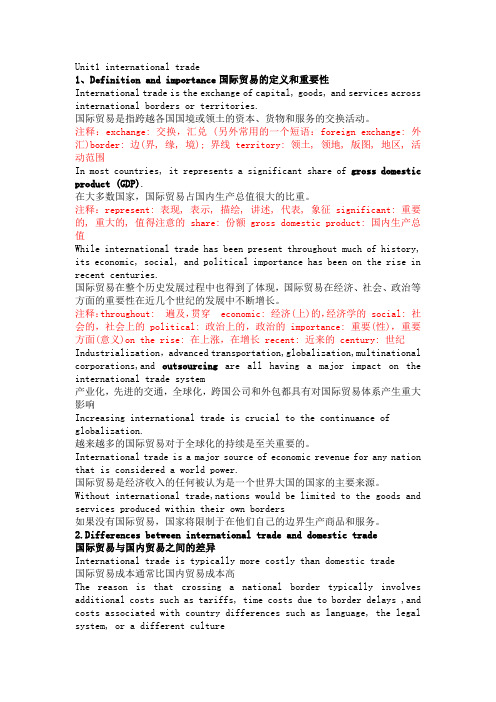
Unit1 international trade1、Definition and importance国际贸易的定义和重要性International trade is the exchange of capital, goods, and services across international borders or territories.国际贸易是指跨越各国国境或领土的资本、货物和服务的交换活动。
注释:exchange: 交换,汇兑 (另外常用的一个短语:foreign exchange: 外汇)border: 边(界, 缘, 境); 界线 territory: 领土, 领地, 版图, 地区, 活动范围In most countries, it represents a significant share of gross domestic product (GDP).在大多数国家,国际贸易占国内生产总值很大的比重。
注释:represent: 表现, 表示, 描绘, 讲述, 代表, 象征 significant: 重要的, 重大的, 值得注意的 share: 份额 gross domestic product: 国内生产总值While international trade has been present throughout much of history, its economic, social, and political importance has been on the rise in recent centuries.国际贸易在整个历史发展过程中也得到了体现,国际贸易在经济、社会、政治等方面的重要性在近几个世纪的发展中不断增长。
注释:throughout: 遍及,贯穿economic: 经济(上)的,经济学的 social: 社会的,社会上的 political: 政治上的,政治的 importance: 重要(性),重要方面(意义)on the rise: 在上涨,在增长 recent: 近来的 century: 世纪Industrialization,advanced transportation,globalization,multinational corporations,and outsourcing are all having a major impact on the international trade system产业化,先进的交通,全球化,跨国公司和外包都具有对国际贸易体系产生重大影响Increasing international trade is crucial to the continuance of globalization.越来越多的国际贸易对于全球化的持续是至关重要的。
国际贸易Unit
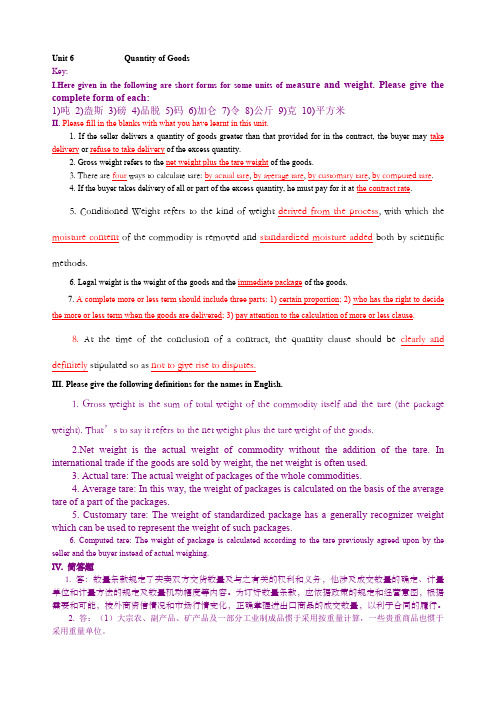
Unit 6 Quantity of GoodsKey:I.Here given in the following are short forms for some units of me asure and weight. Please give the complete form of each:1)吨2)盎斯3)磅4)品脱5)码6)加仑7)令8)公斤9)克10)平方米II. Please fill in the blanks with what you have learnt in this unit.1. If the seller delivers a quantity of goods greater than that provided for in the contract, the buyer may take delivery or refuse to take delivery of the excess quantity.2. Gross weight refers to the net weight plus the tare weight of the goods.3. There are four ways to calculate tare: by actual tare, by average tare, by customary tare, by computed tare.4. If the buyer takes delivery of all or part of the excess quantity, he must pay for it at the contract rate.5. Conditioned Weight refers to the kind of weight derived from the process, with which the moisture content of the commodity is removed and standardized moisture added both by scientific methods.6. Legal weight is the weight of the goods and the immediate package of the goods.7. A complete more or less term should include three parts: 1) certain proportion; 2) who has the right to decide the more or less term when the goods are delivered; 3) pay attention to the calculation of more or less clause.8. At the time of the conclusion of a contract, the quantity clause should be clearly and definitely stipulated so as not to give rise to disputes.III. Please give the following definitions for the names in English.1. Gross weight is the sum of total weight of the commodity itself and the tare (the package weight). That’s to say it refers to the net weight plus the tare weight of the goods. weight is the actual weight of commodity without the addition of the tare. In international trade if the goods are sold by weight, the net weight is often used.3. Actual tare: The actual weight of packages of the whole commodities.4. Average tare: In this way, the weight of packages is calculated on the basis of the average tare of a part of the packages.5. Customary tare: The weight of standardized package has a generally recognizer weight which can be used to represent the weight of such packages.6. Computed tare: The weight of package is calculated according to the tare previously agreed upon by the seller and the buyer instead of actual weighing.IV. 简答题1. 答:数量条款规定了买卖双方交货数量及与之有关的权利和义务,他涉及成交数量的确定、计量单位和计量方法的规定及数量机动幅度等内容。
国际贸易英语 Terms
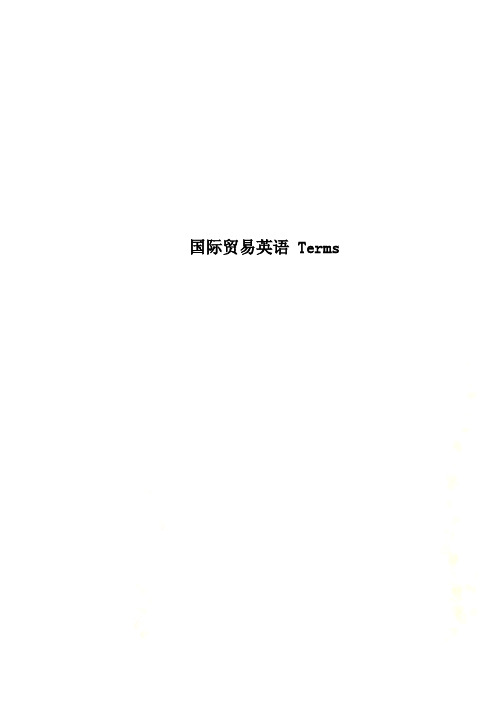
国际贸易英语 Terms国际贸易英语系列一commerce, trade, trading 贸易· inland trade, home trade, domestic trade 国内贸易· international trade 国际贸易· foreign trade, external trade 对外贸易,外贸· import, importation 进口· importer 进口商· export, exportation 出口· exporter 出口商· import licence 进口许口证· export licence 出口许口证· commercial transaction 买卖,交易· inquiry 询盘· delivery 交货· order 订货· make a complete entry 正式/完整申报· bad account 坏帐· Bill of Lading 提单· marine bills of lading 海运提单· shipping order 托运单· blank endorsed 空白背书· endorsed 背书· cargo receipt 承运货物收据· condemned goods 有问题的货物· catalogue 商品目录· customs liquidation 清关· customs clearance 结关stocks 存货,库存量· cash sale 现货· purchase 购买,进货· bulk sale 整批销售,趸售· distribution channels 销售渠道· wholesale 批发· retail trade 零售业· hire-purchase 分期付款购买·fluctuate in line with market conditions 随行就市· unfair competition 不合理竞争· dumping 商品倾销· dumping profit margin 倾销差价,倾销幅度· antidumping 反倾销· customs bond 海关担保· chain debts 三角债· freight forwarder 货运代理· trade consultation 贸易磋商· mediation of dispute 商业纠纷调解· partial shipment 分批装运· restraint of trade 贸易管制·RTA (Regional Trade Arrangements) 区域贸易安排· favorable balance of trade 贸易顺差· unfavorable balance of trade 贸易逆差· special preferences 优惠关税· bonded warehouse 保税仓库· transit trade 转口贸易· tariff barrier 关税壁垒· tax rebate 出口退税·TBT (Technical Barriers to Trade) 技术性贸易壁垒WTO (World Trade Organization) 世界贸易组织· IMF (International Monetary Fund) 国际货币基金组织· CTG (Council for Trade in Goods) 货币贸易理事会· EFTA (European Free Trade Association) 欧洲自由贸易联盟· AFTA (ASEAN Free Trade Area) 东盟自由贸易区· JCCT (China-US Joint Commission on Commerce and Trade) 中美商贸联委会· NAFTA (North American Free TradeArea) 北美自由贸易区· UNCTAD (United Nations Conference on Trade and Development) 联合国贸易与发展会议· GATT (General Agreement on Tariffs and Trade) 关贸总协定trade term / price term 价格术语· world / international market price 国际市场价格· FOB (free on board) 离岸价· C&F (cost and freight) 成本加运费价· CIF (cost, insurance and freight) 到岸价· freight 运费· wharfage 码头费· landing charges 卸货费· customs duty 关税· port dues 港口税· import surcharge 进口附加税· import variable duties 进口差价税· commission 佣金· return commission 回佣,回扣· price including commission 含佣价· net price 净价· wholesale price 批发价· discount / allowance 折扣· retail price 零售价· spot price 现货价格· current price 现行价格/ 时价· indicative price 参考价格· customs valuation 海关估价· price list 价目表· total value 总值trade partner 贸易伙伴· manufacturer 制造商,制造厂· middleman 中间商,经纪人· dealer 经销商· wholesaler 批发商· retailer, tradesman 零售商· merchant 商人,批发商,零售商· concessionaire, licensed dealer 受让人,特许权获得者· consumer 消费者,用户· client, customer 顾客,客户· buyer 买主,买方· carrier 承运人· consignee 收货人国际贸易主业英语词汇Distributorship经销Distributorship agreement经销协议Exclusive sales / exclusive distributorship 独家经销/包销Exclusive distributor独家经销商Right of exclusive sales独家经营权Agency代理Agent代理商Principal委托人Sole / exclusive agency独家代理Exclusive agency agreement独家代理协议Invitation to tender招标Submission of tender投标Bidding documents招标文件Opening of tender开标Auction拍卖Consignment寄售Consignor寄售人Consignee代销商Counter trade对等贸易A barter易货贸易B counterpurchase 互购parallel/reciprocal trade平行贸易/对购C buy-back 回购/ compensation trade补偿贸易D offset抵销Letter of intent意向书MOU: Memorandum of Understanding谅解备忘录Processing trade加工贸易Processing with imported materials进料加工Processing with customer’s materials来料加工Futures trade期货交易Futures market期货市场Commodity exchange商品交易所Clearing house清算所Close price成交价Hedging套期保值Selling hedging卖期保值Buying hedging买期保值FDI: Foreign Direct Investment外国直接投资Fix-capital input固定资本投入Horizontal expansion横向发展International capital movement国际资本流动Anticipated return预期回报Economy of scale规模经济Diseconomy of scale规模不经济usiness stages:A inquiry询盘B offer发盘C counter offer还盘D acceptance接受Selling offer售货发盘Buying offer购货发盘/递盘Invoke撤回The performance of export contract出口合同的履行UNIT 11 MISCELLANEOUSTrade-off权衡Collaboration协作Parent company母公司Subsidiary子公司Licensor许可方Licensee被许可方orporate family公司群Proprietary assets专利资产Operational form经营形式Line/scope of business经营范围Royalty许可使用费Master franchise特约总经销Cross-licensing相互特约经销Franchisee特约经销接受方Franchisor特约经销授权方Vertically integrated company纵向一体化公司Intangible property无形资产Licensing agreement许可协议Sales representative销售代表End user直接用户Overseas agent海外代理Credit investigation资信调查Potential pitfall潜在危险Global concentration面向世界Freight forwarder货运代理Sales record销售记录Piggyback export挂靠才出口Direct selling直销Production capacity生产能力Entry mode切入方式Export revenue出口收入Promotional campaign促销活动Essence of export出口本质Commission agent佣金代理商Export-import strategy进出口策略Commercial invoice商业发票B/L: Bill of Lading提单Consular invoice领事发票Certificate of origin原产地证书Export packing list出口装箱单贸易方式术语stocks 存货,库存量cash sale 现货purchase 购买,进货bulk sale 整批销售,趸售distribution channels 销售渠道wholesale 批发retail trade 零售业hire-purchase 分期付款购买fluctuate in line with market conditions 随行就市unfair competition 不合理竞争dumping 商品倾销dumping profit margin 倾销差价,倾销幅度antidumping 反倾销customs bond 海关担保chain debts 三角债freight forwarder 货运代理trade consultation 贸易磋商mediation of dispute 商业纠纷调解partial shipment 分批装运restraint of trade 贸易管制RTA (Regional Trade Arrangements) 区域贸易安排favorable balance of trade 贸易顺差unfavorable balance of trade 贸易逆差special preferences 优惠关税bonded warehouse 保税仓库transit trade 转口贸易tariff barrier 关税壁垒tax rebate 出口退税TBT (Technical Barriers to Trade) 技术性贸易壁垒wharfage 码头费landing charges 卸货费customs duty 关税port dues 港口税import surcharge 进口附加税import variable duties 进口差价税commission 佣金return commission 回佣,回扣price including commission 含佣价net price 净价wholesale price 批发价discount / allowance 折扣spot price 现货价格current price 现行价格/ 时价indicative price 参考价格customs valuation 海关估价price list 价目表total value 总值。
- 1、下载文档前请自行甄别文档内容的完整性,平台不提供额外的编辑、内容补充、找答案等附加服务。
- 2、"仅部分预览"的文档,不可在线预览部分如存在完整性等问题,可反馈申请退款(可完整预览的文档不适用该条件!)。
- 3、如文档侵犯您的权益,请联系客服反馈,我们会尽快为您处理(人工客服工作时间:9:00-18:30)。
Before course
Steps:
1. Pre-class Report 2. Check-up 3. Lead-in or Preview 4. Unit Contents 5. Summary 6. Homework
Before course
Credits:
attendence: 10% pre-class report: 10% microclassroom study: 20% final test: 60%
Lead-in
Discussion 1. What is international trade? 2. Do you think foreign trade is important to a country or region? Why or why not?
Unit Contents
1.1 Concept of International Trade
Listening Practice two
Listen to the third of this topic and fill in the following blanks. Chinese officials say they want to reduce the state control businesses and economic influence of to let market forces shape the economy . However, economists expect China’s growth to slow in the coming years. How quickly that happens depends on several issues . The recovery of the United States and European economies means rising demand for Chinese exports .
2.2 Reasons for International Trade
Why do you think the international trade can happen?
2.2 Reasons for International Trade
Different countries have comparative advantages on different products. For import: cost and availability For export: surplus new products difference competition economies of scales cost, price and domestic contraction
Unit 1 Overview of International Trade
1.Unit Points
1
Objectives Preview and Lead-in
2
3
Contents
Objectives
Key points
★Concept of International Trade
Difficult points
1.1 Concept of International Trade
Since 1978, China has seen steady growth in its foreign trade. The following table shows this. (In hundred million USD)
Listening Practice one
B. Listen to the second part of this topic and fill in the following blanks. China’s economy had 10 percent growth rate in the years before the world financial crisis of 2008. That
APEC
AFTA
1.1 Concept of International Trade
3. Merchandise Trade and Trade in services
trade in goods visible/tangible trade visible/tangible goods/products service trade invisible/intangible goods/products intellectual property rights
Listening Practice two
Listen to this topic again and fill the following blanks. Chinese officials say they want to reduce the economic influence of and to let market forces . However, economists expect China’s growth to slow in the coming years. How quickly that happens depends on several . The recovery of the United States and European economies means .
1980 Imp. 195.5 Exp. 182.7 1990 533.5 620.9 1995 1320.8 1487.8 2808.6 2000 2250.9 2492.0 4742.9 2005 6601 7620 14221 2008 11330 14285 25615 2013 19315 22285 41600 2014 18156 23376 43000 2015 16820 22765 39586
6820 2105
Imp.
4503 3291
Balance
2317 -1184
Listening Practice one
A. Listen and decide whether the following questions are true or not. 1.The year 2013 sees the slowest economic growth rate since 1999. 2.Economy grows in 2013 as fast as it does in 2012. 3.The government predicted that China’s economy would grow at about 7.5 percent in 2013. 4.it is easy to keep growth high and inflation low at the same time. 5.According to China’s statistics director, China has done a great job by keeping the economy at high growth rate and inflation at low speed.
2.2 Reasons for International Trade Listening Practice
1.1 Concept of International Trade
1. International Trade
Exchange of goods or services between countries or regions.
economic expansion resulted from big trade surpluses and foreign investment . Now, says Ma Jiantang, China is seeking to move away from that growth model . The country is working to balance exports with demand at home.
★International Trade ★Merchandise Trade and Trade in Services
★Deficits and Surpluses
preview
International trade trade deficits trade surpluses merchandise trade(or visible trade, trade in goods) trade in services(or invisible trade)
is the unification of economic policies between different states through the partial or full abolition of tariff and non-tariff restrictions on trade taking place among them . NAFTA EU
Brazil
1.1 Concept of International Trade
China and U.S.: Service trade section in 2013
(In hundred million USD)
Total
U.S. China PRC 11323 (1) 5396 (3)
Exp.
Import Export
Imp. 2015 16820 22765 39586 5945
Deficits
Surpluses
Exp. Total balance
(In hundred million USD)
